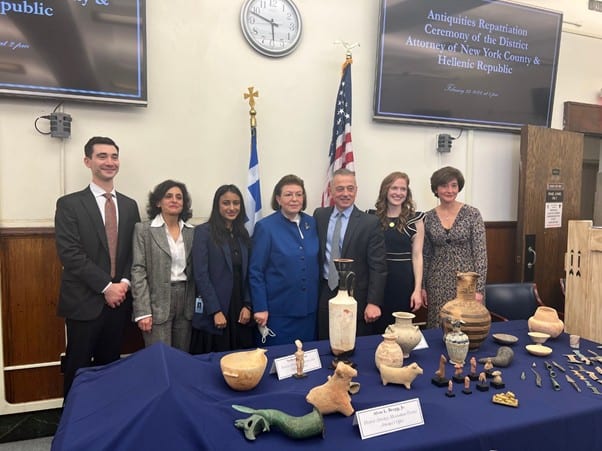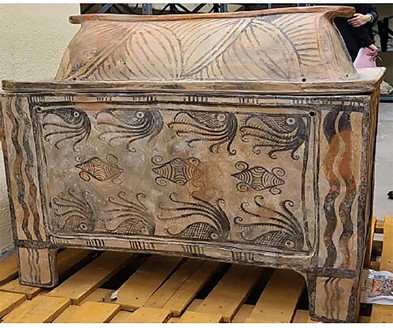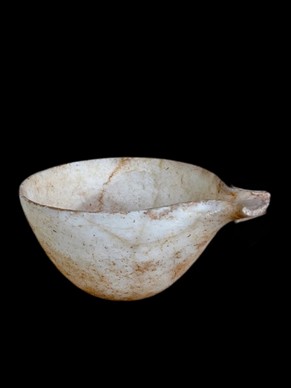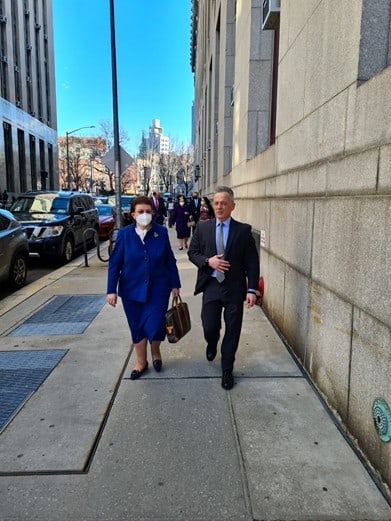In the opening lines of Homer’s Odyssey the wandering hero Odysseus longs for the day of his homecoming, for his νόστιμον ἦμαρ (pronounced nostimon imar) which means literally ‘the day of my return’.

On 23 February 2022 the Greek Minister of Culture, Dr Lina Mendoni, was in New York to take possession of over fifty stolen ancient Greek artefacts recovered with the assistance of the Manhattan District Attorney’s Office in New York and in her speech ended by declaring that it was truly a sweet day of return of antiquities after years of wandering, changes in illegal ownership and falsified records. These rare antiquities are now finally coming home because, as the Culture Minister noted, they are forever intertwined with the history of the place that gave birth to them.
This was an excellent example of Hellenic-American cultural co-operation. For some years the Manhattan District Attorney’s Office has pursued the recovery of illicitly-removed cultural property. The team includes the Assistant District Attorney, Matthew Bogdanos, a classics scholar and former miliary lawyer who served in Iraq and wrote a famous work, The Thieves of Baghdad, about the looting of Iraq museums during the Gulf War. Since 2018 Bogdanos has headed the antiquities-trafficking bureau in New York and is quite passionate about his work.
The story of how these antiquities were recovered began to unfold some years ago when Michael Steinhardt, a billionaire and philanthropist as well as one of the world’s largest ancient art collectors, came on to the radar of the Manhattan District Attorney’s Office. After extensive investigations and meticulous analysis and cross-checking of the provenance of numerous antiquities, investigators were able to unravel their chains of custody through prominent dealers, galleries, auction houses, private collectors and major museums. They also identified criminal smuggling networks that looted, smuggled, laundered and transferred antiquities as part of this grand cultural theft.
In a media release issued in December 2021 by the then NY District Attorney, Cyrus Vance Jr, Steinhardt was accused of having “a rapacious appetite for plundered artifacts without concern for the legality of his actions” and “decades-long indifference to the rights of peoples to their own sacred treasures”. The insatiable art collector instead relied on a “sprawling underworld of antiquities traffickers, crime bosses, money launderers and tomb raiders” to build his collection.
In all 180 stolen antiquities valued at $70 million were seized from the Steinhardt collection. They had been looted and illegally smuggled out of eleven different countries, including Italy, Greece, Egypt and Israel, prior to their sale to Steinhardt. In a deal struck between the NY District Attorney and Steinhardt’s lawyers, in exchange for not being prosecuted the billionaire collector forfeited those artefacts and accepted a (albeit problematic) lifetime ban from acquiring antiquities in the future.
Of the 55 ancient objects that were returned to Greece at the formal handover ceremony in New York, 47 came from the Steinhardt collection and originated from Central Greece, Crete, the Cyclades (Paros, Naxos), Samos, and Rhodes.
They include some stunning objects:

A Greek white-ground attic lekythos – or oil vessel – from the 5th century BC depicting a funeral scene with the figures of a woman and a youth, had first surfaced in the international art market in 1995 when it was in the possession of a now disgraced London art dealer, Robin Symes, before being eventually acquired by Steinhardt in 2006 despite the lack of any verifiable provenance records.

Arguably the most valuable piece that is being returned is the marble trunk of a Kouros which Steinhardt purchased from Robert Hecht, a notorious (now deceased) Paris-based antiquities dealer in November 2000. The Kouros was crafted in around 560 BCE and depicts a youth with 14 rows of braids and is characteristic of kouroi found in archaeological sites in Greece. The Kouros appears broken, dirty, covered in graffiti written in Greek, and lying on a pallet in the dirt in two photographs recovered from Steinhardt’s files. According to experts, the images are consistent with those taken by looters shortly after illicit excavations to attempt to prove the authenticity of antiquities to prospective buyers.

Another rich artefact, a Larnax - a small chest for human remains crafted in an ancient workshop of Rethymnon in Crete between 1400 -1200 BCE - was purchased by Steinhardt from a known antiquity smuggler in around 2014 despite reports of widespread looting on the island at around that time. From a photograph recovered from Steinhardt’s files the larnax, which features painted aquatic figures, appeared to have been broken into several large fragments and later ‘reconstructed’ so as to avoid detection by customs and other law enforcement officials.

The Spouted Bowl, which dates to 2700-2200 BCE, was taken from a site on the Cycladic Island of Paros by looters acting on the orders of another infamous dealer in plundered antiquities, Giacomo Medici, who had for over forty years organised gangs to steal carefully chosen and insufficiently guarded archaeological sites throughout Italy and Greece, including Paros, Crete and parts of the Greek mainland.
According to the statement of facts prepared by the New York District Attorney’s Office, Greece was among the first nations in the world to pass laws to protect antiquities. In 1834, following the Greek War of Independence, the newly-created nation state enacted a law which decreed that “all objects of antiquity in Greece, being the productions of the ancestors of the Hellenic people, are regarded as the common national possession of all Hellenes”. A new consolidated patrimony law was introduced in 2002 for the protection of antiquities and cultural heritage and expressly prohibiting the export of any cultural objects from Greek territory without a permit from the Minister of Culture.
Under US law, once a country establishes a patrimony law, its declaration of national ownership suffices to render an illegally exported item ‘stolen’. So, if a nation like Greece declares ownership of antiquities buried beneath the ground, legal title to those antiquities remains with the country even after they are unearthed by looters and smuggled out of the country. Once stolen, always stolen.
With the prospect of litigation hanging over him, like the proverbial Sword of Damocles, Steinhardt chose to settle and relinquish all claims to the stolen treasures.

At the ceremony the new Manhattan District Attorney, Alvin Bragg, stated that he was honoured to return these magnificent cultural treasures to the people of Greece and pointed out that each piece is an “irreplaceable display of Greece’s enduring strength, history and cultural heritage”.
The Greek Culture Minister thanked the District Attorney’s Office and their excellent cooperation with the Directorate for Documentation and Protection of Cultural Goods of the Hellenic Ministry of Culture and Sports, adding that the “illegal trafficking of the cultural treasures of our country is a serious trauma that hurts all Greeks around the world" and that “every repatriation of illegally exported cultural goods to Greece means another precious piece of our history and culture has been returned”.
In particular, Dr Mendoni also praised the efforts of Matthew Bogdanos for his determined efforts and work. Bogdanos who is of Greek heritage (his father is from Lemnos) was magnanimous in his speech:
“All these things are very important to me. It is not just the beauty of an archaeological object. I know where these objects dame from, I remember the archaeological sites themselves. Continue to feel proud of our cultural heritage and privilege of being called Greeks, because it is a privilege. Continue to earn this privilege, to earn it day by day.”
Whilst in New York the Greek Culture Minister gave an interview to the National Herald during which she reiterated that the issue of the return of the Parthenon Sculptures from the British Museum and their reunification in Athens remains a priority for the Greek Government, as highlighted by the recent initiatives of Prime Minister Kyriakos Mitsotakis in bringing the issue back into the international spotlight.
Dr Mendoni referred to the decision in September 2021 by the UNESCO Intergovernmental Committee for Promoting the Return of Cultural Property to its Countries of Origin that recognised Athens’ request as being fair and legitimate and urged the United Kingdom to reconsider its position and engage in a meaningful and bona fide dialogue with Greece. The Culture Minister also noted that conditions around the world have noticeably changed in recent times with the return of forcibly removed cultural property from the countries that created them and to which they belong, a reference no doubt to the recent return by France of looted African art and similar steps to be pursued by Belgium, the Netherlands and Germany as well as a number of museums in respect of contested heritage such as the Benin Bronzes.
Dr Mendoni concluded by affirming that the Parthenon Sculptures belong to Greece and must be reunited with the mutilated monument. She pointedly added that the international climate is extremely positive for Greece’s legal and moral request that the Parthenon, the symbol of Western Civilisation and Democracy, must have its integrity finally restored.
As with the ancient treasures returned in New York, Greece still longs for the Parthenon Sculptures to come home. The day of their return will not only be a delightful and joyous occasion, but it will give a new meaning to that immortal Homeric phrase νόστιμον ἦμαρ.
George Vardas is Co-Vice Chair, Australian Parthenon Committee and
Co-Founder, The Acropolis Research Group
